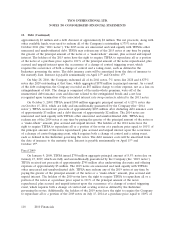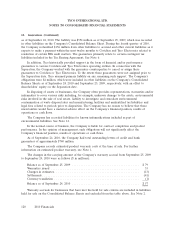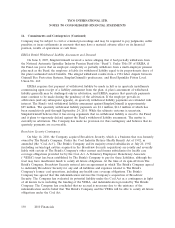ADT 2010 Annual Report Download - page 210
Download and view the complete annual report
Please find page 210 of the 2010 ADT annual report below. You can navigate through the pages in the report by either clicking on the pages listed below, or by using the keyword search tool below to find specific information within the annual report.-
 1
1 -
 2
2 -
 3
3 -
 4
4 -
 5
5 -
 6
6 -
 7
7 -
 8
8 -
 9
9 -
 10
10 -
 11
11 -
 12
12 -
 13
13 -
 14
14 -
 15
15 -
 16
16 -
 17
17 -
 18
18 -
 19
19 -
 20
20 -
 21
21 -
 22
22 -
 23
23 -
 24
24 -
 25
25 -
 26
26 -
 27
27 -
 28
28 -
 29
29 -
 30
30 -
 31
31 -
 32
32 -
 33
33 -
 34
34 -
 35
35 -
 36
36 -
 37
37 -
 38
38 -
 39
39 -
 40
40 -
 41
41 -
 42
42 -
 43
43 -
 44
44 -
 45
45 -
 46
46 -
 47
47 -
 48
48 -
 49
49 -
 50
50 -
 51
51 -
 52
52 -
 53
53 -
 54
54 -
 55
55 -
 56
56 -
 57
57 -
 58
58 -
 59
59 -
 60
60 -
 61
61 -
 62
62 -
 63
63 -
 64
64 -
 65
65 -
 66
66 -
 67
67 -
 68
68 -
 69
69 -
 70
70 -
 71
71 -
 72
72 -
 73
73 -
 74
74 -
 75
75 -
 76
76 -
 77
77 -
 78
78 -
 79
79 -
 80
80 -
 81
81 -
 82
82 -
 83
83 -
 84
84 -
 85
85 -
 86
86 -
 87
87 -
 88
88 -
 89
89 -
 90
90 -
 91
91 -
 92
92 -
 93
93 -
 94
94 -
 95
95 -
 96
96 -
 97
97 -
 98
98 -
 99
99 -
 100
100 -
 101
101 -
 102
102 -
 103
103 -
 104
104 -
 105
105 -
 106
106 -
 107
107 -
 108
108 -
 109
109 -
 110
110 -
 111
111 -
 112
112 -
 113
113 -
 114
114 -
 115
115 -
 116
116 -
 117
117 -
 118
118 -
 119
119 -
 120
120 -
 121
121 -
 122
122 -
 123
123 -
 124
124 -
 125
125 -
 126
126 -
 127
127 -
 128
128 -
 129
129 -
 130
130 -
 131
131 -
 132
132 -
 133
133 -
 134
134 -
 135
135 -
 136
136 -
 137
137 -
 138
138 -
 139
139 -
 140
140 -
 141
141 -
 142
142 -
 143
143 -
 144
144 -
 145
145 -
 146
146 -
 147
147 -
 148
148 -
 149
149 -
 150
150 -
 151
151 -
 152
152 -
 153
153 -
 154
154 -
 155
155 -
 156
156 -
 157
157 -
 158
158 -
 159
159 -
 160
160 -
 161
161 -
 162
162 -
 163
163 -
 164
164 -
 165
165 -
 166
166 -
 167
167 -
 168
168 -
 169
169 -
 170
170 -
 171
171 -
 172
172 -
 173
173 -
 174
174 -
 175
175 -
 176
176 -
 177
177 -
 178
178 -
 179
179 -
 180
180 -
 181
181 -
 182
182 -
 183
183 -
 184
184 -
 185
185 -
 186
186 -
 187
187 -
 188
188 -
 189
189 -
 190
190 -
 191
191 -
 192
192 -
 193
193 -
 194
194 -
 195
195 -
 196
196 -
 197
197 -
 198
198 -
 199
199 -
 200
200 -
 201
201 -
 202
202 -
 203
203 -
 204
204 -
 205
205 -
 206
206 -
 207
207 -
 208
208 -
 209
209 -
 210
210 -
 211
211 -
 212
212 -
 213
213 -
 214
214 -
 215
215 -
 216
216 -
 217
217 -
 218
218 -
 219
219 -
 220
220 -
 221
221 -
 222
222 -
 223
223 -
 224
224 -
 225
225 -
 226
226 -
 227
227 -
 228
228 -
 229
229 -
 230
230 -
 231
231 -
 232
232 -
 233
233 -
 234
234 -
 235
235 -
 236
236 -
 237
237 -
 238
238 -
 239
239 -
 240
240 -
 241
241 -
 242
242 -
 243
243 -
 244
244 -
 245
245 -
 246
246 -
 247
247 -
 248
248 -
 249
249 -
 250
250 -
 251
251 -
 252
252 -
 253
253 -
 254
254 -
 255
255 -
 256
256 -
 257
257 -
 258
258 -
 259
259 -
 260
260 -
 261
261 -
 262
262 -
 263
263 -
 264
264 -
 265
265 -
 266
266 -
 267
267 -
 268
268 -
 269
269 -
 270
270 -
 271
271 -
 272
272 -
 273
273 -
 274
274 -
 275
275 -
 276
276 -
 277
277 -
 278
278 -
 279
279 -
 280
280 -
 281
281 -
 282
282 -
 283
283 -
 284
284 -
 285
285 -
 286
286 -
 287
287 -
 288
288 -
 289
289 -
 290
290 -
 291
291 -
 292
292
 |
 |
TYCO INTERNATIONAL LTD.
NOTES TO CONSOLIDATED FINANCIAL STATEMENTS
13. Financial Instruments (Continued)
Foreign Currency Exposures
The Company manages foreign currency exchange rate risk through the use of derivative financial
instruments comprised principally of forward contracts on foreign currency, which are not designated as
hedging instruments for accounting purposes. The objective of those derivatives instruments is to
minimize the income statement impact and potential variability in cash flows associated with
intercompany loans and accounts receivable, accounts payable and forecasted transactions that are
denominated in certain foreign currencies. As of September 24, 2010 and September 25, 2009, the total
gross notional amount of the Company’s foreign exchange contracts was $860 million and $525 million,
respectively. Effective March 17, 2009, Tyco changed its jurisdiction of incorporation from Bermuda to
Switzerland. Until the last payment is made in February 2011, Tyco intends to make dividend payments
in the form of a reduction of capital, denominated in Swiss francs. However, the Company expects to
actually pay these dividends in U.S. dollars, based on exchange rates in effect shortly before the
payment date. Fluctuations in the value of the U.S. dollar compared to the Swiss franc between the
date the dividend is declared and paid will increase or decrease the U.S. dollar amount required to be
paid. The Company manages the potential variability in cash flows associated with the dividend
payments by entering into derivative financial instruments used as economic hedges of the underlying
risk.
During the third quarter of 2010, the Company hedged its net investment in certain foreign
operations through the use of foreign exchange forward contracts. The objective is to minimize the
exposure to changes in the value of the foreign currency denominated net investment. The aggregate
notional amount of these hedges was approximately $255 million as of September 24, 2010. As of
September 25, 2009, the Company did not hedge any net investments in foreign operations.
Interest Rate Exposures
The Company manages interest rate risk through the use of interest rate swap transactions with
financial institutions acting as principal counterparties, which are designated as fair value hedges for
accounting purposes. During the third quarter of 2009, first quarter of 2010 and third quarter of 2010,
the Company entered into interest rate swap transactions with the objective of managing the exposure
to interest rate risk by converting the interest rates on $1.4 billion, $500 million and $501 million
respectively, of fixed-rate debt to variable rates. In these contracts, the Company agrees with financial
institutions acting as principal counterparties to exchange, at specified intervals, the difference between
fixed and floating interest amounts calculated on an agreed-upon notional principal amount. In
connection with the redemption of all of the 6.375% public notes due 2011 during the third quarter of
2010, the Company terminated the corresponding interest rate swaps. As of September 24, 2010 and
September 25, 2009, the total gross notional amount of the Company’s interest rate swap contracts was
$1.5 billion and $1.4 billion, respectively.
Commodity Exposures
During fiscal 2010, the Company entered into commodity swaps for copper which are not
designated as hedging instruments for accounting purposes. These swaps did not have a material impact
on the Company’s financial position, results of operations or cash flows.
122 2010 Financials
